Lac Erhai, Dali - Billets, heures d'ouverture, emplacement et points forts
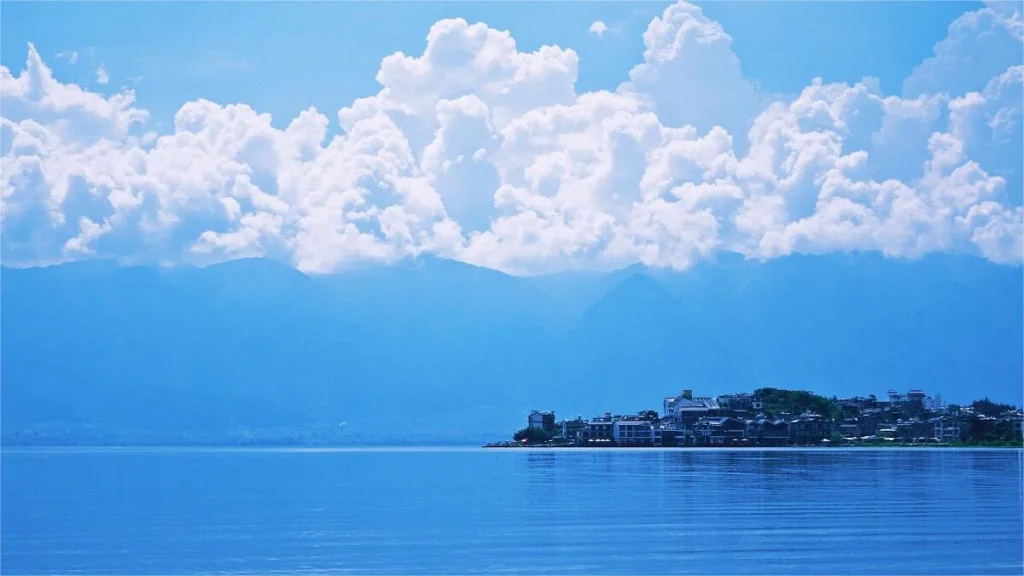
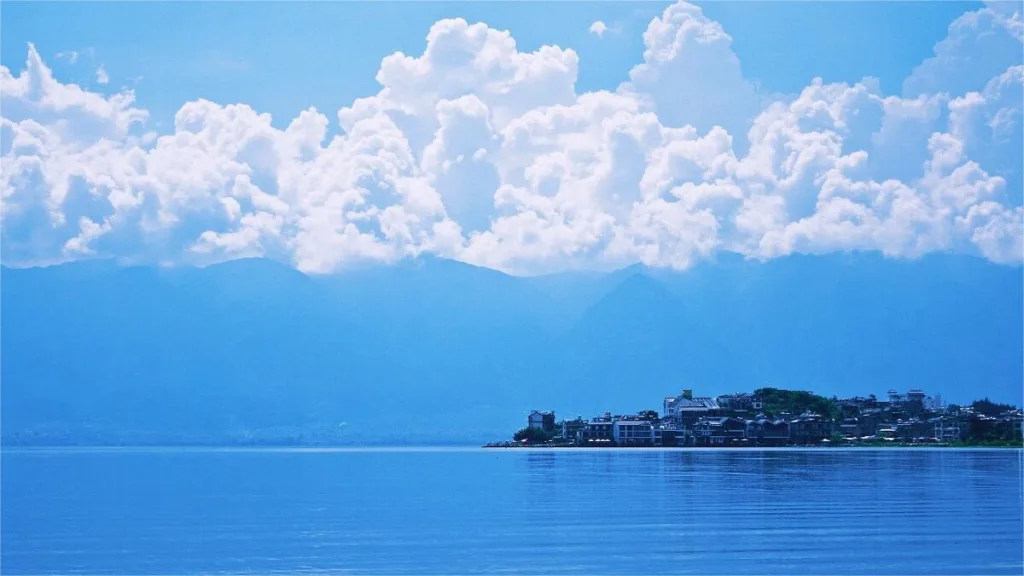
Erhai Lake (洱海), also known as Kunming Pool, Er River, or Yeyu Lake in ancient times, is located in Dali City, Dali Bai Autonomous Prefecture, Yunnan Province, China. With a surface area of approximately 246 square kilometers (or 252 square kilometers according to some sources), it holds a water volume of about 2.95 billion cubic meters. Shaped like a narrow ellipse, it stretches from the southern tip of Eryuan County to Xiaguan in Dali City, with a length of 40 kilometers from north to south. It is the second-largest lake in Yunnan Province, following only Dianchi Lake.
Formed during the late glacial period, Erhai Lake is primarily a result of tectonic subsidence erosion, making it a structural fault basin lake at an elevation of 1972 meters above sea level. The name “Erhai” is believed to have originated from its shape resembling a human ear or a crescent moon embracing an ornament, while the term “Hai” (meaning sea) is commonly used in Yunnan to refer to lakes. The lake’s crystal-clear waters, often described as “flawless jade among the mountains,” add to its allure.
Along the shores of Erhai Lake, there are picturesque villages such as Shuanglang, known for its “Erhai Lake Divine Light,” Caicun, a filming location for the movie “In the Mood for Love,” and Xizhou, famous for its distinctive Bai ethnic architecture. These villages offer visitors a glimpse into the rich cultural heritage and stunning natural scenery that surround the lake.
Table des matières
Informations de base
| Durée estimée de la visite | 1 - 2 jours |
| Prix du billet | Free, but you need to pay for the various attractions |
| Heures d'ouverture | 24 heures tout au long de l'année |
Localisation et transport
Erhai Lake is located in Dali City, Dali Bai Autonomous Prefecture, Yunnan Province, China. It stretches from the north of Dali Railway Station to the eastern part of Dali Ancient City, with its western edge reaching Hai Dong Town and its northern part extending to Shuanglang Town. Most tourists choose to stay in Shuanglang Town or Dali Ancient City, and there are buses available directly from the railway station to these destinations.
Highlights of Erhai Lake
Jin Suo Island

Jin Suo Island, the largest island in Erhai Lake, was once known as Zhongliu Island during the Nanzhao Kingdom era. In the Bai ethnic language, it is referred to as “Chuanuo,” meaning island. Situated in the southeastern part of Erhai Lake, it is approximately 12 kilometers south of Xiaguan and 6 kilometers west of Dali Ancient City. Stretching approximately 2 kilometers in length and with an average width of 370 meters, Jin Suo Island covers a total area of around 740,000 square meters, making it the largest of the three islands in Erhai Lake. Legend has it that a celestial maiden, skilled in weaving colorful brocade, accidentally dropped her golden shuttle into Erhai Lake, which then transformed into Jin Suo Island, becoming a earthly paradise.
Yuji Island

Yuji Island, one of the three islands in Erhai Lake, is located on the western side of the lake. It was formerly known as Gongji Island or Tiansheng Camp and is renowned as the “First Village of Cang Erhai.” The island is named after the Yuji Temple located on it. Yuji Island preserves many well-preserved traditional Bai ethnic dwellings alongside modern structures, including the famous “Green Cottage” extending into Erhai Lake and Yang Liping’s “Sun Palace” and “Moon Palace.”
Nanzhao Folk Island

Nanzhao Folk Island, situated in the northeastern part of Erhai Lake opposite Shuanglang Village, is a small island boasting stunning scenery and a variety of unique guesthouses. The island features an artificial sandy beach, making it an ideal spot for enjoying views of Erhai Lake and capturing memorable moments, such as wedding photoshoots. Upon disembarking from the ferry onto the island, visitors are greeted by the Sand Sculpture Group depicting a mythological tale from the Dali region, as recorded in the “Records of the Later Han Dynasty.” Continuing onward, one encounters the Fortune Star Square, one of the main attractions on the island.
Chiwen Island
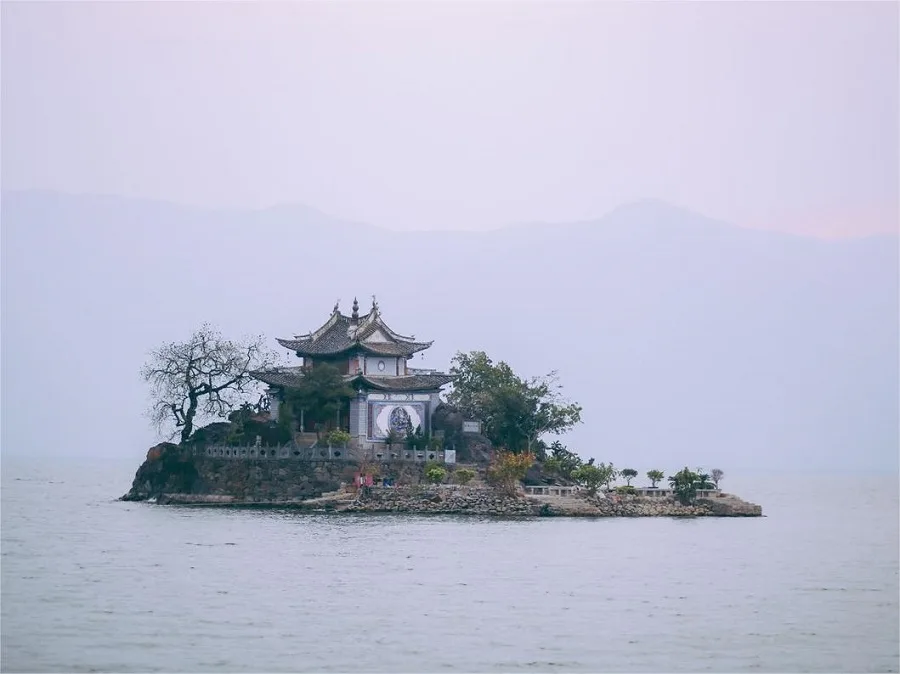
Chiwen Island, also known as Lueshan Island, is one of the three famous islands in Erhai Lake, located within the territory of Wase Town, Dali City. It is said that Chiwen Island was once a fully surrounded island in Erhai Lake, but over time, due to changes in the earth’s crust and the lowering of the water level in Erhai Lake, it gradually transformed into a peninsula. Viewed from afar, Chiwen Island resembles a reclining tiger majestically poised amidst the waves of Erhai Lake. Its coastline is dotted with rugged reefs and charming beaches. Inhabited by the Bai ethnic group since the Neolithic period, the island features architectural marvels such as the flying eaves of Guanyin Pavilion to the north, Baixian Terrace and Baiyu Cave to the south, and the ancient Altar for Sacrificing to Heaven at the island’s peak, all overlooking the distant Haiyin Xiaoputuo Island. The crystal-clear waters surrounding the island are teeming with schools of fish, while various waterfowl find refuge along its shores.
Cangshan Mountain
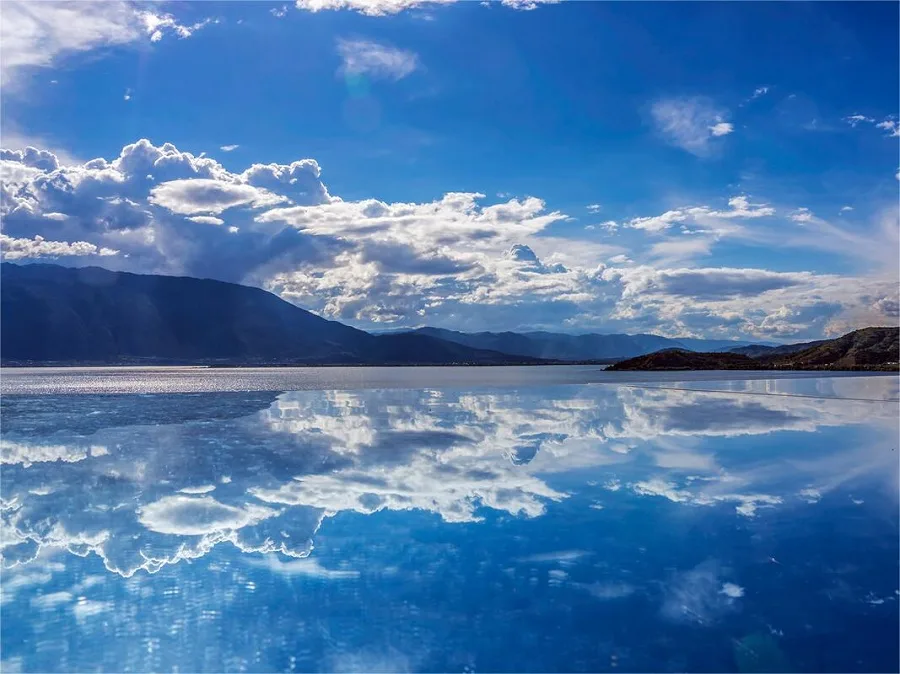
Cangshan Mountain, also known as Diancang Mountain, is the main peak at the southern end of the Yunling Mountain Range, boasting nineteen peaks from north to south. Stretching 48 kilometers from north to south and approximately 10 kilometers from east to west, Cangshan Mountain stands as a majestic backdrop to the scenic beauty of Erhai Lake. Each peak of Cangshan Mountain, including Xiayang Peak, Ma’er Peak, Foding Peak, Shengying Peak, Malong Peak, Yujufeng Peak, Longquan Peak, Zhonghe Peak, Guanyin Peak (also known as Xiaocen Peak), Ying Le Peak, Xueren Peak, Lan Peak, Sanyang Peak, Heyun Peak, Baiyun Peak, Lianhua Peak, Wutai Peak, Canglang Peak, and Yunlong Peak, is characterized by its towering grandeur. Flowing between each pair of peaks are the famous Eighteen Streams, cascading down into Erhai Lake. With its high altitude, many peaks of Cangshan Mountain soar to over 2000 meters, with Yujufeng, Longquan, Ying Le, and Lan peaks reaching heights of over 4000 meters, while the highest peak, Malong Peak, towers at 4122 meters above sea level.
Chongsheng Temple Three Pagodas

The Chongsheng Temple Three Pagodas, located at the foothills of the Yingle Peak of Cangshan Mountain, approximately 1 kilometer northwest of Dali Ancient City, stand as a majestic symbol of ancient architecture and Buddhist heritage. Originally part of the Chongsheng Temple complex, which has since been destroyed, these three pagodas remain as enduring monuments. The main pagoda, known as Qianxun Pagoda, is a square, hollow brick structure built during the Tang Dynasty, resembling the Small Wild Goose Pagoda in Xi’an. Soaring to a height of 69.13 meters and comprising 16 stories, it exemplifies the intricate architectural style of the Tang Dynasty. Flanking the main pagoda are two smaller pagodas, each standing 70 meters away and constructed during the Song Dynasty. These octagonal, hollow brick pagodas, standing at a height of 42.19 meters with 10 stories each, showcase the elegance of Song Dynasty architecture. During extensive repairs from 1978 to 1980, over 680 artifacts dating back to the Nanzhao Kingdom of Dali were unearthed, providing invaluable insights into the region’s history.
Butterfly Spring
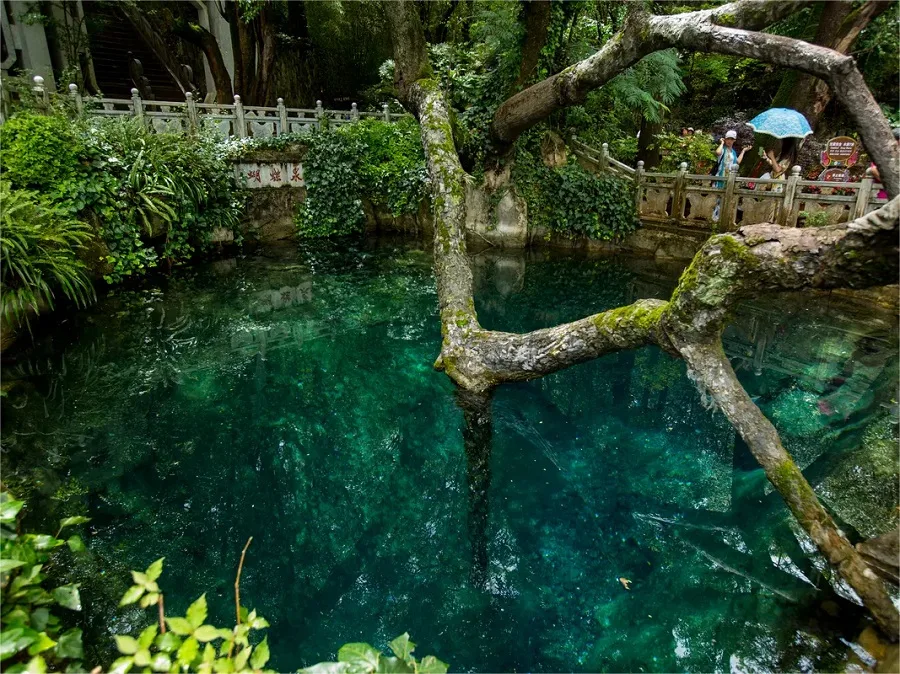
Butterfly Spring, nestled at the foot of the Yunlong Peak of Cangshan Mountain, approximately 24 kilometers north of Dali Ancient City, is a tranquil oasis renowned for its natural beauty and ethereal charm. Water gushes from the sandstone, forming a clear, emerald-green pool spanning over 20 square meters. Encircled by lush greenery and protected by marble railings, the spring is adorned with a magnificent ancient Twin Fragrance tree, whose reflection dances upon the water’s surface, creating an enchanting spectacle. Every April, butterflies flock to the spring, filling the air with their graceful fluttering and forming a mesmerizing display known as the Butterfly Spring Phenomenon. The site also features a Butterfly Museum, Ocean Pavilion, Butterfly Monument, and a stone carving of Xu Xiake, offering visitors an immersive experience amidst nature’s splendor.
Nanzhao Dehua Stele
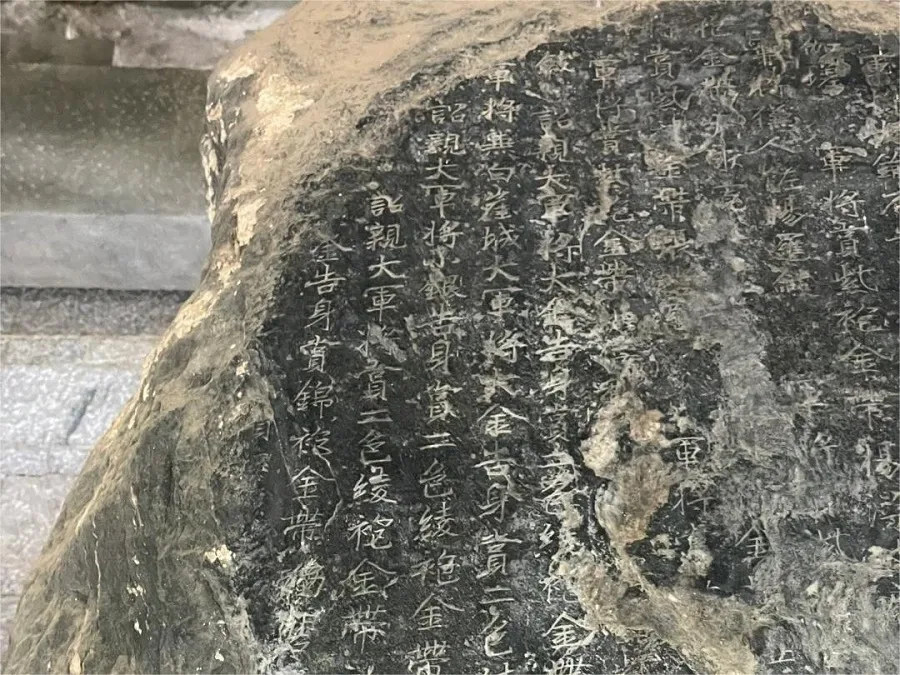
The Nanzhao Dehua Stele, erected within a Tang Dynasty-style stone pavilion at the site of the Taihe City Ruins in Dali City, stands as a testament to the early history of the Nanzhao Kingdom and its relationship with the Tang Dynasty. Standing at a height of 4.02 meters and featuring inscriptions on both sides totaling over 5100 characters, the stele eloquently recounts the early history of Nanzhao and its interactions with the Tang Dynasty, including the causes and events of the Tianbao War. Its exquisite craftsmanship and intricate calligraphy make it a treasure trove of historical and cultural significance.
Du Wenxiu Commander’s Mansion
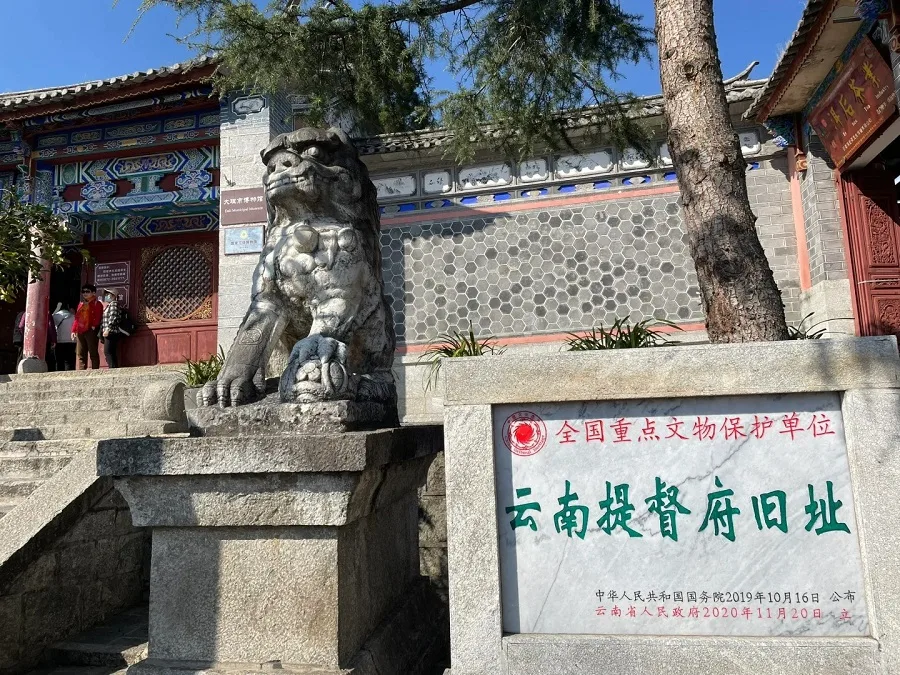
The Du Wenxiu Commander’s Mansion, located on the main street of Nanmen in Zhenhe Town, Dali City, stands as a testament to the Taiping Rebellion led by Du Wenxiu in 1856. After capturing the ancient city of Dali, Du Wenxiu was elected as the “Commander-in-Chief of the Army and Horses” and established the Dali regime. The original Dali Prefectural Office was transformed into the Commander’s Mansion, surrounded by a new earthen wall known as the Purple Forbidden City. Today, remnants of the mansion, including the main gate, sections of the city wall, the inner gate of the mansion, the Baihu Hall, and adjacent buildings, still stand as a reminder of this turbulent period in history. The mansion underwent renovations by Governor Cen Yuying after the rebellion’s failure.
Dali Bai Autonomous Prefecture Museum

The Dali Bai Autonomous Prefecture Museum, situated on Erbin Road in Xiaguan Town, Dali City, was established in 1984 and spans an area of 60 acres. The museum’s architecture follows the layout of a Bai ethnic residence with three courtyards and a decorative screen wall. Its exhibits prominently feature the history of the Nanzhao and Dali kingdoms, as well as the diverse cultures of the Bai Autonomous Prefecture. With its rich ethnic characteristics, the museum frequently hosts Bai ethnic “Three Tea” evening events, attracting visitors from both domestic and international locales.
Tianjing Pavilion

The Tianjing Pavilion, located atop Yuan Mountain in Haidong Township, Dali City, was originally constructed during the Ming Dynasty and earned its name, meaning “Heavenly Mirror Pavilion,” for its breathtaking views of Erhai Lake. Though the original pavilion has since been destroyed, a reconstruction now stands on its former site. Nearby, the renowned Luoquan Temple and Luoquan Pagoda once stood, though the pagoda has sadly succumbed to time. Nevertheless, a smaller version of the Luoquan Temple has been rebuilt in the area.
Lac Zibi

Lac Zibi, also known as Ning Lake, is located at the foot of Bagu Mountain, 4 kilometers northeast of Dali County. Its name derives from the precious aquatic plant known as Cibi Flower that thrives within its waters. This lake, formed by seismic subsidence, stretches over 8 square kilometers and boasts a unique charm. Surrounded by lush greenery and fed by the Fengyu River and Meizi River, Zibi Lake offers a serene escape from the hustle and bustle of city life. The area is renowned for its abundance of hot springs. These sulfur springs not only provide opportunities for bathing but also offer health benefits, making them a popular destination for wellness seekers. Additionally, the lake’s underwater hot springs create a mesmerizing natural spectacle, with bubbles forming patterns resembling blooming flowers, adding to the area’s allure.
Ancient City of Dali

The ancient city of Dali stands as a testament to the region’s rich history and cultural significance. Situated at the eastern edge of Erhai Lake and nestled against the backdrop of the Cangshan Mountains, this historic city has been a center of civilization for centuries. Originally established in 1382 during the Ming Dynasty, the city was strategically positioned to overlook the former capital of the Nanzhao and Dali kingdoms. Today, remnants of its past glory remain, with parts of the city walls and gates still intact. The layout of the city reflects a chessboard-like pattern, with well-preserved streets, lanes, and traditional Bai ethnic residences characterized by white walls, gray tiles, and intricately carved wooden decorations. Within the ancient city, visitors can explore a wealth of cultural landmarks, including temples, academies, and churches, each contributing to the area’s ambiance of timeless elegance and charm.
Attractions de Dali, Paysages du Yunnan